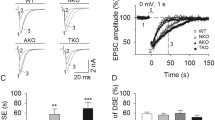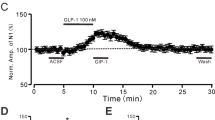Abstract
Cytosolic phospholipase A2 alpha (cPLA2α) responds to micromolar intracellular Ca2+ and produces arachidonic acid, which regulates cellular homeostasis, neurotoxicity, and inflammation. Endocannabinoids are the derivates of arachidonic acid and widely distributed in the cerebellum. However, the role of cPLA2α/arachidonic acid pathway in cerebellar synaptic transmission and plasticity is unknown. We utilized cPLA2α knockout mice and slice whole-cell patch clamp to study the action of cPLA2α/arachidonic acid signaling on the depolarization-induced suppression of excitation (DSE) and long-term potentiation at parallel fiber–Purkinje cell synapses. Our data showed that DSE was significantly inhibited but rescued by arachidonic acid in cPLA2α knockout mice. The degradation enzyme of 2-arachidonoylglycerol (2-AG), monoacylglycerol lipase, blocked DSE, while another catabolism enzyme for N-arachidonoylethanolamine, fatty acid amide hydrolase, did not, suggesting that 2-AG is responsible for DSE in Purkinje cells. Co-application of paxilline reversed the blockade of DSE by internal K+, indicating that large-conductance Ca2+-activated potassium channel is sufficient to inhibit cPLA2α/arachidonic acid-mediated DSE. On the other hand, we found that 1 Hz parallel fiber stimuli-triggered long-term potentiation (LTP) was deficient in cPLA2α knockout mice. LTP was also inhibited when AACOCF3, an inhibitor of cPLA2α, was given. Arachidonic acid was necessary for the LTP induction. Therefore, these data showed that cPLA2α/arachidonic acid/2-AG signaling pathway mediates DSE and LTP at parallel fiber–Purkinje cell synapse.

Similar content being viewed by others
References
Evans JH, Leslie CC. The cytosolic phospholipase A2 catalytic domain modulates association and residence time at Golgi membranes. J Biol Chem. 2004;279:6005–16.
Bonventre JV, Huang Z, Taheri MR, O’Leary E, Li E, Moskowitz MA, et al. Reduced fertility and postischaemic brain injury in mice deficient in cytosolic phospholipase A2. Nature. 1997;390:622–5.
Kalyvas A, David S. Cytosolic phospholipase A2 plays a key role in the pathogenesis of multiple sclerosis-like disease. Neuron. 2004;41:323–5.
Shen Y, Kishimoto K, Linden DJ, Sapirstein A. Cytosolic phospholipase A2 alpha mediates electrophysiologic responses of hippocampal pyramidal neurons to neurotoxic NMDA treatment. Proc Natl Acad Sci U S A. 2007;104:146078–83.
Malcher-Lopes R, Franco A, Tasker JG. Glucocorticoids shift arachidonic acid metabolism toward endocannabinoid synthesis: a non-genomic anti-inflammatory switch. Eur J Pharmacol. 2008;583:322–39.
Safo PK, Regehr WG. Endocannabinoids control the induction of cerebellar LTD. Neuron. 2005;48:647–59.
Howlett AC, Breivogel CS, Childers SR, Deadwyler SA, Hampson RE, Porrino LJ. Cannabinoid physiology and pharmacology: 30 years of progress. Neuropharmacol. 2004;47:345–58.
Kreitzer AC, Regehr WG. Retrograde inhibition of presynaptic calcium influx by endogenous cannabinoids at excitatory synapses onto Purkinje cells. Neuron. 2001;29:717–27.
Cravatt BF, Demarest K, Patricelli MP, Bracey MH, Giang DK, Martin BR, et al. Supersensitivity to anandamide and enhanced endogenous cannabinoid signaling in mice lacking fatty acid amide hydrolase. Proc Natl Acad Sci U S A. 2001;98:9371–6.
Dinh TP, Carpenter D, Leslie FM, Freund TF, Katona I, Sensi SL, et al. Brain monoglyceride lipase participating in endocannabinoid inactivation. Proc Natl Acad Sci U S A. 2002;99:10819–24.
Xiang Z, Burnstock G. Changes in expression of P2X purinoceptors in rat cerebellum during postnatal development. Dev Brain Res. 2005;156:147–57.
Walter L, Dinh T, Stella N. ATP induces a rapid and pronounced increase in 2-arachidonoylglycerol production by astrocytes, a response limited by monoacylglycerol lipase. J Neurosci. 2004;24:8068–74.
Lev-Ram V, Wong ST, Storm DR, Tsien RY. A new form of cerebellar long-term potentiation is postsynaptic and depends on nitric oxide but not cAMP. Proc Natl Acad Sci U S A. 2002;99:8389–93.
Belmeguenai A, Hansel C. A role for protein phosphatases 1, 2A, and 2B in cerebellar long-term potentiation. J Neurosci. 2005;25:10768–72.
Le TD, Shiraia Y, Okamotob T, Tatsukawab T, Nagaob S, Shimizuc T, et al. Lipid signaling in cytosolic phospholipase A2α–cyclooxygenase-2 cascade mediates cerebellar long-term depression and motor learning. Proc Natl Acad Sci U S A. 2010;107:3198–203.
Acknowledgments
We thank Dr. Adam Sapirstein (Johns Hopkins University, Baltimore, MD) for providing the cPLA2α knockout mice. We are grateful for helpful advice from members of Shen’s lab. This work was supported by the National Foundation of Natural Science of China (30600168, 31070945, 31100780 and 31200818) and the Foundation of Zhejiang Educational Committee, China (Y201121662 and Y20070109).
Conflict of interest
There are no conflicts of interest for Li-Da Su, De-Juan Wang, Dong Yang, Ying Shen, and Ying-Hong Hu.
Author information
Authors and Affiliations
Corresponding authors
Additional information
Li-Da Su and De-Juan Wang contributed equally to this work.
Rights and permissions
About this article
Cite this article
Su, LD., Wang, DJ., Yang, D. et al. Retrograde cPLA2α/Arachidonic Acid/2-AG Signaling Is Essential for Cerebellar Depolarization-Induced Suppression of Excitation and Long-Term Potentiation. Cerebellum 12, 297–299 (2013). https://doi.org/10.1007/s12311-012-0444-9
Published:
Issue Date:
DOI: https://doi.org/10.1007/s12311-012-0444-9




